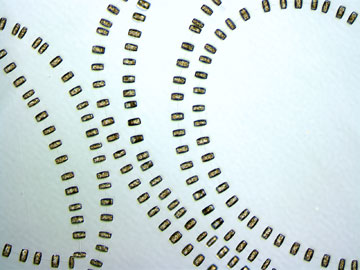Diatoms are responsible for significant amounts of marine primary production. In response to favorable light and nutrient conditions, diatoms rapidly divide and form large blooms. As blooms propagate, nutrients are depleted, growth ceases, and cells sink to the deep ocean. The sinking diatom blooms fuel the biological carbon pump and export carbon from the atmosphere to the deep ocean. Diatoms generate about 40% of the 45 to 50 billion tons of organic carbon fixed annually in the sea and as much as 90% of the photosynthetically produced organic carbon that fuels coastal ecosystems. According to some predictions, their role in global carbon cycling is comparable to that of all terrestrial rain forests combined.

Thalassiosira rotula isolated from a bloom in the North Atlantic. Each barrel-shaped object is one cell of the diatom. The cells are held together by silica spindles.(photo courtesy T. Rynearson, Univ. of Rhode Island)
Because of their significance in global carbon cycling, the DOE JGI has pioneered the sequencing of diatom genomes and has completed sequencing of two distantly related species, Thalassiosira pseudonana and Phaodactylum tricornutum. Although these genomes are invaluable for understanding the molecular underpinnings of diatom biology, they are primarily laboratory models and do not form large blooms in the ocean. Now, JGI plans to use transcriptional profiling approaches to understand how new isolates of a bloom-forming, abundant, and globally distributed diatom in the genus Thalassiosira, T. rotula, responds to nutrient and light limitation. This research will fundamentally advance our understanding of how diatoms acquire nutrients, how these strategies are regulated, how different isolates of the same species respond to stress, and how they respond to multiple stressors. These data are expected to open the door for molecular investigations of unsequenced diatom species in the field and provide a framework for future genome-enabled studies of diatoms.
Principal Investigators: Bethany D. Jenkins (Univ. of Rhode Island), Sonya Dyhrman (Woods Hole Oceanographic Institute), Tatiana Rynearson (Univ. of Rhode Island) and Mak Saito (Woods Hole Oceanographic Institute)
Program: CSP 2009